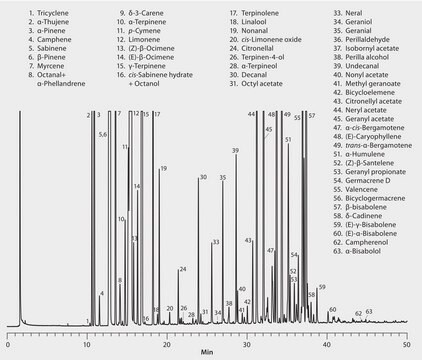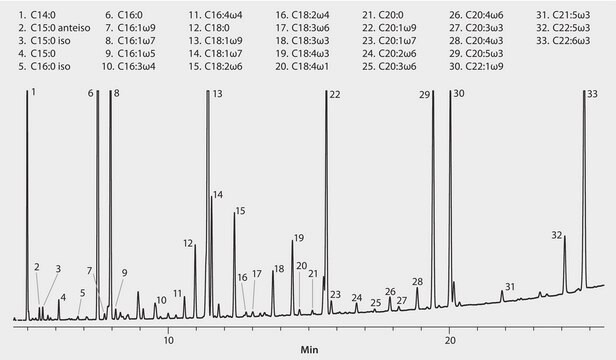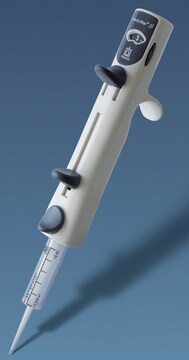28467-U
SLB®-5ms Capillary GC Column
L × I.D. 30 m × 0.25 mm, df 0.10 μm
Synonim(y):
Kolumna GC, SPB-5, 5% difenyl, spec. masowa
About This Item
Polecane produkty
Materiały
fused silica
agency
Standard Method 6040D
EN 2005/108/EC
EPA 610,625,8015,8082,8100,8141,8270,OLM04.2 SVOA
EPA TO-13,IP-8,8270,525.2,608.1/608.2,608/8081/OLM04.2 PEST
JMHLW
NIOSH 2530,5503
OSHA 62
meets requirements for USP G27 and G36
suitable for EPA 1613
zgodność regionalna
FDA LIB 4423
Parametry
-60-340 °C temperature (isothermal)
-60-360 °C temperature (programmed)
Wartość beta
625
df
0.10 μm
metody
GC/MS: suitable
gas chromatography (GC): suitable
dł. × śr. wewn.
30 m × 0.25 mm
grupa aktywna macierzy
Bonded and highly crosslinked; silphenylene polymer virtually equivalent in polarity to poly(5% diphenyl/95% dimethyl siloxane) phase
Zastosowanie
agriculture
chemicals and industrial polymers
cleaning products
clinical
cosmetics
environmental
flavors and fragrances
food and beverages
forensics and toxicology
industrial hygiene
life science and biopharma
personal care
petroleum
pharmaceutical (small molecule)
typ kolumny
capillary non-polar
Szukasz podobnych produktów? Odwiedź Przewodnik dotyczący porównywania produktów
Opis ogólny
USP Code: This column meets USP G27 and G36 requirements.
Phase:
- Bonded and highly crosslinked
- Silphenylene polymer virtually equivalent in polarity to poly(5% diphenyl/95% dimethyl siloxane)
- ≤0.32 mm I.D.: -60 °C to 340 °C (isothermal) or 360 °C (programmed)
- ≥0.53 mm I.D.: -60 °C to 330 °C (isothermal) or 340 °C (programmed)
Zastosowanie
- Ulepszonametoda oznaczania cyjanków we krwi z wykorzystaniem mikroekstrakcji do fazy stałej i chromatografii gazowej / spektrometrii masowej...: Niniejsze badanie przedstawia ulepszoną metodę oznaczania poziomu cyjanku we krwi, wykorzystującą mikroekstrakcję do fazy stałej w połączeniu z chromatografią gazową / spektrometrią mas. Technika ta poprawia czułość i dokładność, niezbędną do analizy toksykologicznej i kryminalistycznej (Frison et al., 2006).
- Fotochemiczna produkcja sprzężonego kwasu linolowego z oleju sojowego ..: Badania te dotyczą fotochemicznej produkcji sprzężonego kwasu linolowego (CLA) z oleju sojowego. W badaniu wykorzystano chromatografię gazową do analizy CLA, demonstrując skuteczną metodę produkcji tego cennego związku o potencjalnych korzyściach zdrowotnych (Gangidi & Proctor, 2004).
- Opracowanie procedury mikroekstrakcji GC-NPD w fazie stałej do oznaczania wolnych lotnych amin w ściekach i wodach zanieczyszczonych ściekami...: Niniejsza praca opisuje opracowanie procedury GC-NPD wykorzystującej mikroekstrakcję do fazy stałej do wykrywania lotnych amin w ściekach. Metoda ta oferuje lepsze granice wykrywalności i specyficzność, które są krytyczne dla monitorowania środowiska i oceny jakości wody (Abalos et al., 1999).
Inne uwagi
Informacje prawne
rozpuszczalnik
Wybierz jedną z najnowszych wersji:
Masz już ten produkt?
Dokumenty związane z niedawno zakupionymi produktami zostały zamieszczone w Bibliotece dokumentów.
Produkty
Sigma-Aldrich presents an article about the analysis of melamine and related compounds in dog food with the use of more economical gas chromatography-mass spectrometry (GC-MS) instrumentation.
Nasz zespół naukowców ma doświadczenie we wszystkich obszarach badań, w tym w naukach przyrodniczych, materiałoznawstwie, syntezie chemicznej, chromatografii, analityce i wielu innych dziedzinach.
Skontaktuj się z zespołem ds. pomocy technicznej




